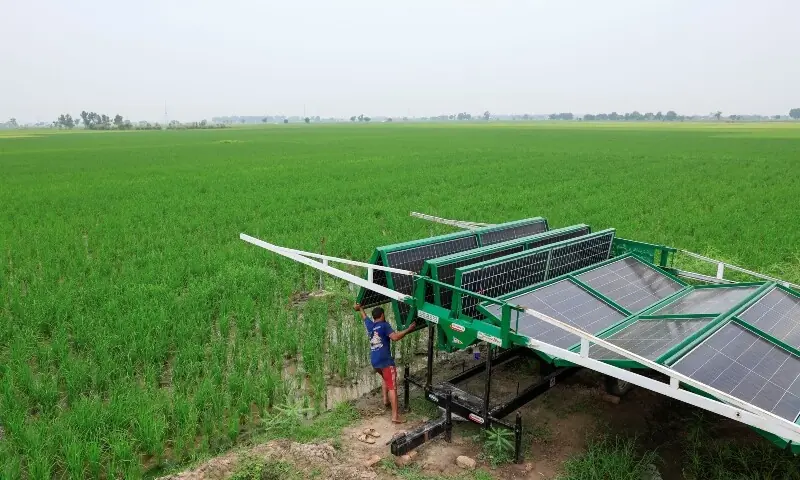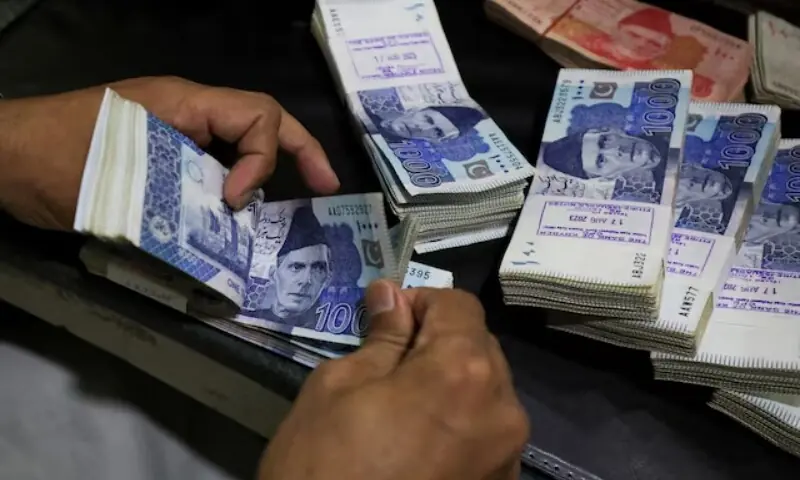The roof of a huge rice mill in the eastern district of the commercial capital Karachi is covered in sky-blue solar panels that absorb the rays of the scorching midday sun.
The factory is one of thousands of industrial units across Pakistan that have switched to solar energy to counter rising electricity tariffs and frequent power outages in recent years.
The South Asian country of around 255 million people has seen an uptake of solar energy, particularly in the past two years, after an International Monetary Fund (IMF) bailout forced Pakistan to sharply increase power and gas tariffs to support struggling suppliers in the heavily indebted energy sector.
From pharmaceuticals to cement manufacturers in Karachi, to textile units in Faisalabad and from supermarkets to mosques in Lahore, solar panels combined with lithium batteries have been adopted as an alternative to electricity from the national grid.
“We were left with no choice but to go solar as electricity bills had become literally unpayable for industrialists,” said Rafique Suleman, the factory owner. Anadolu.
Suleman said going solar “really” helped him mitigate the rate challenge, saving him up to 50 percent of his monthly energy-related expenses.
“The current electricity tariffs and Pakistan’s industry cannot survive together. Solar energy is the only viable option for local industrialists to run their businesses,” added Suleman, former president of the country’s rice exporters association.
Mehwish Salman Ali, CEO of Data Vault Pakistan, a leading data provider and management solutions company, sees solar solutions as a “game changer” that helps the country address chronic energy deficits by providing affordable and reliable energy to homes and businesses.
“From crippling blackouts and incredibly high bills, we’ve seen solar’s share of electricity generation triple to 14 percent by 2025, with rural areas reaching 25 percent in just the first few months, filling the gaps where the grid fails us,” Ali said. Anadolu.
Pakistan’s solar penetration places it among Asia’s leaders in solar-only participation, surpassing nations such as China (9 percent) and India (6 percent), according to Ember, a UK-based energy think tank.
Environmental challenges
Although solar solutions have contributed significantly to reducing energy gaps, environmentalists warn that e-waste is adding to a long list of environmental challenges already affecting the country.
Pakistan is among the 10 countries most affected by climate change.
The adoption of solar energy in the country has accelerated rapidly since 2015 due to rising electricity rates, frequent power outages, falling panel prices and net metering incentives.
Currently, Pakistan is estimated to have around 3 million consumers using solar systems, including off-grid ones, according to the 2023 Seventh Census of Population and Housing. China exported 16.6 gigawatts of solar capacity to Pakistan in 2024, about five times more than in 2022.
“While solar energy is a clean and renewable energy source, electronic waste (e-waste) generated by its components – particularly solar panels, inverters and batteries – is an emerging environmental challenge in Pakistan and around the world,” said Rafiul Haq, a Karachi-based environmentalist. Anadolu.
Most systems use lead-acid, lithium-ion, or gel batteries and panels with a lifespan of 10 to 25 years. When they reach the end of their life, they become e-waste, often unmanaged, Haq added.
Supporting the view, Ali said that without affordable solar options, the energy gap widens, increasing dependence on fossil fuels, which harms the environment and hinders progress towards sustainable development. A 2023 United Nations Development Program (UNDP) report estimated that more than 80% of lead-acid battery recycling in Pakistan is unregulated, exposing workers and nearby communities to neurotoxic lead.
Pakistan currently does not have any facilities dedicated to battery recycling or solar energy, according to Haq.
He said the first wave of solar panels installed between 2010 and 2015 are nearing the end of their useful life. Without a recycling system, millions of panels could generate thousands of tons of e-waste annually over the next decade.
“The solution lies in strong recycling legislation, formal waste collection systems and producer responsibility frameworks, turning clean energy into a truly sustainable system,” Haq said, calling for the establishment of a “National Solar E-Waste Management Framework.”
Mustafa Amjad, an Islamabad-based energy expert, said the existing power system “isn’t really ready for all that solar power. That doesn’t mean it doesn’t have to be ready. It’s still going to have to make that trip, a little sooner than initially thought,” he said. Anadolu.
“And it would need new regulatory structures.”
Social division
Waqar Phulpoto, director general of Sindh Environment Protection Authority (SEPA), said the e-waste problem is not alarming for now.
“This is a reality, and it will certainly be an environmental challenge. But at the moment, its scope is not huge, as Pakistan has seen a boom in solar energy adoption in the last five years,” Phulpoto said. Anadolu.
SEPA is considering introducing legislation and guidelines “soon” to address the e-waste issue, he said, adding: “Much will be done before this issue (e-waste) becomes a real challenge,” Phulpoto said.
On average, Pakistanis now pay more than a quarter of their income on electricity, sparking a scramble for clean energy alternatives.
While wealthier home and commercial consumers are reaping the benefits of solar solutions, many poor communities are left behind or only enjoying daytime relief. This gap is especially evident in densely populated urban areas with small homes and limited access to electricity.
In rural areas, where long power outages are common, those who cannot afford to install battery panels use individual solar panels to keep fans running during the day. Wealthier farmers use solar-powered tube wells with backup batteries to pump water at night.
This current energy crisis, Ali said, also stifles economic growth, particularly in rural areas where access to reliable energy is already limited.
Earlier this year, Prime Minister Shehbaz Sharif’s government slightly reduced electricity tariffs after negotiations with independent power producers and cut some taxes following public outcry. However, according to experts, prices are still high for the common consumer.








